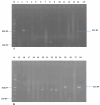Antimicrobial resistance markers distribution in Staphylococcus aureus from Nsukka, Nigeria
- PMID: 38491352
- PMCID: PMC10943768
- DOI: 10.1186/s12879-024-09126-1
Antimicrobial resistance markers distribution in Staphylococcus aureus from Nsukka, Nigeria
Abstract
Background: Multidrug resistance in Staphylococcus aureus continues to influence treatment complications in clinical settings globally. Multidrug-resistant-S. aureus (MDR-SA) is often genetically driven by resistance markers transferable in pathogenic strains. This study aimed to determine the distribution of resistance markers in clinical isolates of S. aureus in Nsukka, Nigeria.
Methods: A total of 154 clinical samples were cultured on mannitol salt agar. Isolates were characterized using conventional cultural techniques and confirmed by PCR detection of S. aureus-specific nuc gene. Antibiotic resistance profiles of the isolates were determined against selected antibiotics using the disk-diffusion method, while screening for antibiotic resistance genes (Mec A, Erm A, Erm B, Erm C, Van A, and Van B) was by PCR.
Results: A total of 98 isolates were identified as S. aureus by conventional methods. Of these, 70 (71.43%) were confirmed by PCR. Phenotypically, the isolates exhibited high degrees of resistance to oxacillin (95.72%), erythromycin (81.63%), and ertapenem (78.57%) and 75.51% and 47.30% against methicillin and vancomycin, respectively. Multiple antibiotic resistance indexes of the isolates ranged from 0.3 to 1, and the most prevalent pattern of resistance was oxacillin-ertapenem-vancomycin-erythromycin-azithromycin-clarithromycin-ciprofloxacin- cefoxitin-amoxicillin-clavulanic acid. PCR screening confirmed the existence of various antibiotic resistance makers among the strains, with the most common resistance genes found in the isolates being Mec A (32.14%), Van A (21.43%), Van B (10.71%), Erm B (10.71%), and Erm C (17.86%). None possessed the Erm A gene.
Conclusion: The study supports the need for necessary action, including rational drug use, continuous surveillance, and deployment of adequate preventive and curative policies and actions.
Keywords: S. Aureus; Antibiotic resistance; Genes; Markers.
© 2024. The Author(s).
Conflict of interest statement
The authors declare no competing interests.
Figures






References
-
- World Health Organization. Antimicrobial Resistance. 2021. https://www.who.int/news-room/fact-sheets/detail/antimicrobial-resistance. Accessed 27 June 2022.
-
- Financial Times Limited. Antibiotic resistance in Africa: ‘a pandemic that is already here’. Available from: https://www.ft.com/content/95f150df-5ce6-43cf-aa8d-01ac3bdcf0ef; Accessed 26: 2022.
-
- Ndihokubwayo JB, Yahaya AH, Desta AT, Ki-Zerbo G, Odei EA, Keita B, et al. Antimicrobial resistance in the African Region: issues, challenges and actions proposed. Volume 16. WHO Regional Office for Africa; 2013. pp. 27–30.
-
- Saleem N, Nawaz M, Ghafoor A, Javeed A, Mustafa A, Yousuf MR, et al. Phenotypic and Molecular Analysis of Antibiotic Resistance in Lactobacilli of Poultry origin from Lahore, Pakistan. Pak Vet J. 2018;38(4):409–13. doi: 10.29261/pakvetj/2018.084. - DOI
MeSH terms
Substances
LinkOut - more resources
Full Text Sources
Medical
Miscellaneous

